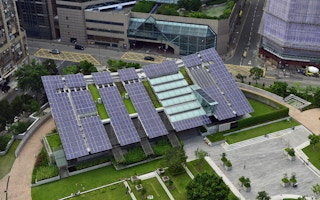In a recently published report, the International Renewable Energy Agency (IRENA) traces the development of solar photovoltaic and its dramatic decline in costs.
IRENA Director-General Adnan Z. Amin says in REthinking Energy — the first edition in a new IRENA series — that solar PV costs fell by two-thirds between the end of 2009 and 2013 – “a speed of change comparable to that seen in the IT revolution.”
Indeed, PV prices have fallen by 80 per cent since 2008 and are expected to keep dropping. Furthermore, the report says commercial solar power reached grid parity last year in Italy, Germany and Spain and will do so soon in Mexico and France.
Solar deployment outpaced wind for the first time in 2013, reaching around 38 GW and 2014 is expected to be a record year for both solar PV and wind power.
Increased efficiencies and decreasing technology costs, against a backdrop of rising electricity prices, have allowed solar PV to reach new levels of cost competitiveness, according to IRENA’s findings.
“
The combination of reductions in PV module prices and balance of systems costs has allowed the levelised cost of energy to fall rapidly
Solar PV is increasingly competing without subsidies: power from a new 70 MW solar farm under construction in Chile, for example, is anticipated to sell on the national spot market, competing directly with fossil fuel-based electricity.
Between 2009 and 2013, prices for solar PV modules declined by 65 per cent-70 per cent, despite module prices stabilising in 2013. The technology reached new levels of competitiveness at both distributed and utility scale. The cost of residential solar PV systems in Germany declined by 53 per cent in the same period.
The report found that technology cost reductions have been driven by:
- Efficiency improvements: The efficiency of solar PV modules in converting sunlight into electricity has improved by around 3 per cent-4.5 per cent per year for the last 10 years
- Economies of scale: Integrated factories are scaling up processes, providing competitive equipment prices and amortizing fixed costs over larger output
- Production optimisation: More efficient production processes and improvements in supply chain management continue to provide cost reduction opportunities.
IRENA points out that the combination of reductions in PV module prices and balance of systems (BoS) costs has allowed the levelised cost of energy (LCOE) to fall rapidly. Assuming a weighted average cost of capital of 10 per cent, LCOE for solar PV has declined to as low as $0.11 per kilowatt hour and is typically in the range of $0.15 to $0.35/kWh for utility-scale projects. The cost of deployment and the LCOE, however, differ from market to market, IRENA adds.
“Improving the competiveness of PV will therefore increasingly depend on the extent that BoS costs can be reduced. While the trend in BoS costs is downwards at present, this is a diverse area with significant national variance.”
Indeed, it is much cheaper to install the same solar panel in Germany than in the United States or Japan due to regulations, the availability of skilled installation professionals and other factors.
Investments in renewable energy
Investments in renewable energy have risen significantly over the past decade, from $55 billion to $214 billion between 2004 and 2013 (excluding large hydropower). Despite investments in renewable energy dipping 11 per cent in 2013, renewable energy deployment hit record levels, with solar PV and wind capacity growing 37 per cent and 12.5 per cent respectively, reflecting decreasing costs.
Also examining other forms of renewable energy, the report found that in Denmark, wind recently became the cheapest energy source of all, beating out even coal. In Germany, almost half of all renewable generation is now owned by households and farmers, marking a profound shift in control.
“These and other developments have made renewables increasingly attractive in many more markets,” the report points out.
For the first time last year new renewable capacity installations were higher in countries that are not members of the Organization for Economic Co-operation and Development (OECD). China’s deployment of solar PV and wind in 2013 was estimated at 27.4 GW: nearly four times that of the next largest, Japan.
Worldwide, renewable power capacity has grown 85 per cent over the past 10 years, reaching 1,700 GW in 2013. Renewables today make up 30 per cent of all installed power capacity.
The challenge for renewable energy now is no longer whether it can power modern lifestyles at a reasonable cost – which it obviously can – but rather how best to finance and accelerate its deployment, IRENA says.
Despite a 22 per cent decline in global renewables investments in 2013, falling costs allowed renewables to be deployed at unparalleled scale, the report adds.
Total installed capacity of renewable power reached 1,700 GW in 2013, or 30 per cent of total global power capacity. The renewable share of electricity generation exceeded 22 per cent for the first time: with 16.4 per cent hydro, 2.9 per cent wind, 1.8 per cent bio-power and 1.1 per cent solar PV, concentrated solar power (CSP), geothermal and ocean.
The scale of uptake has expanded greatly over the past decade, rising from under 20 per cent to 58 per cent of net additions to global power capacity in 2013.










